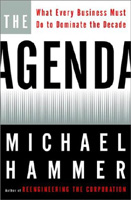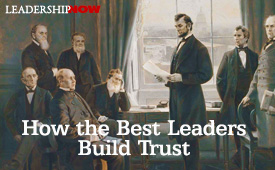
Get Serious About Business Again | Reading Room BY MICHAEL HAMMER |
Welcome to the Customer Economy
Suddenly, business is not so easy anymore. For a very brief period in the late 1990s, it seemed that all the problems of business had been solved. Everywhere one turned, enterprises were booming. Established companies were racking up record sales and earnings. Start-ups were deluged with capital. Everyone was doing well, and everyone was making money. Growth and success were taken for granted. Confidence was high. Customers were spending. The stock market was moving in one direction only--up. Anyone seemed to be able to win at business. Knowledge, technique, and experience were not needed, only energy, gumption, and attitude. The new American dream had nothing to do with working hard and long to build a business but featured instead hanging out with some buddies, coming up with a cool idea, and "going public" in a year or so. The business zeitgeist, as promoted by self-proclaimed visionaries, was that we were in a "New Economy," in which the business cycle had become a thing of the past. The Internet had changed everything, and mundane issues like cost and quality and inventory had become irrelevant. Not anymore. The longest economic expansion in U.S. history is winding down, and the giddy days of the 1990s are now mere memories. As of this writing, the business media are no longer reporting on plants running over capacity, on companies scrambling to fill positions, or on venture-funded start-ups revolutionizing this industry or that. Instead, we are hearing about layoffs and store closings, energy shortages and soaring costs, decreased advertising and lower profits, missed earnings expectations and steep stock market declines. Business school applications are up, and IPOs are down. Businesspeople's smugness has given way to anxiety. They can no longer take growth for granted or assume that this year will be better than last. Now they must worry whether customers will buy, costs will rise, or competitors will overtake them. They lie awake wondering if the fundamental premises of their businesses will remain valid. They are shocked to find that markets go down as well as up and that growth has to be created, not just harvested. Managers are learning again that most new ideas do not succeed, that many companies fail, that resources are always scarce, and that above all, business is not a game for amateurs. Managers are rediscovering that business is about execution. It is not about having the right "business model" or capturing eyeballs, about creating a really cool work space or planning a launch party. Suddenly bereft of inflated stock market evaluations--a cushion that on the one hand allowed companies to make acquisitions for free and to pay their people with options instead of money, and that on the other made customers feel rich and free-spending--businesspeople are back to watching every penny. They have been reminded that it's not enough to get the order, you have to fill it; that having an idea for a product does you no good if you can't develop it; and that even Wall Street analysts will be fooled by a hot concept only for so long. Business today is no longer about grand visions and the arrogance of youth. The time is past for frivolous notions and flights of fancy. Business today is about nuts and bolts, the mechanics of making companies work. It is serious stuff. Even if the current downturn proves to be brief, even if fiscal and monetary policymakers pull more rabbits out of their hats, there will be no return to the state of innocence of the 1990s. Just as a generation of investors was permanently scarred by the Great Depression, a generation of managers has been transformed by the collapse of the bubble of the late 1990s. They have become modest and serious, fearful of their environment and uncertain about their futures. This is as it should be. The halcyon days of the 1990s were an aberration. Tough times are the norm. Only rarely do external events conspire to give us an environment in which businesses can operate nearly effortlessly. The 1950s were one such period, when the United States alone had an intact economy with which to take advantage of the postwar expansion. The late 1990s was another. But between such occasional interludes, business is very difficult indeed. In ordinary times, businesspeople must wrest market share from their competitors, motivate customers to part with scarce cash, earn success instead of having it handed to them, and wake up each morning knowing that all of yesterday's accomplishments count for nothing today. This was what we faced in the 1970s, in the aftermath of the energy crisis, and in the 1980s, when we confronted the onslaught of Japanese imports. It is what we encounter today and will continue to face in the future. In short, today's managers have rediscovered that business is not easy. Management has always been and continues to be among the most complex, risky, and uncertain of all human endeavors. Indeed, how could anyone have ever thought otherwise? If managing were simple, why do the majority of businesses fail? If physicians had the same success rate as executives, the medical schools would have been shuttered long ago. If managing were simple, why do so many new products founder in the marketplace? From the Ford Edsel to the Apple Newton and New Coke, the business landscape is littered with the remains of can't-miss products that did. If managing were simple, why do even companies that become successful stay that way for such short periods of time? Why did Pan Am go out of business, why is Xerox near bankruptcy, why did Digital Equipment fall victim to acquisition? Why have such former industry titans as Lucent and General Motors, Levi Strauss and Rubbermaid, become mere shadows of their former selves? If managing were simple, how do leading companies allow themselves to be overtaken by upstarts? How could Nokia have stolen a march on Motorola? Why do giant banks now stand in awe of GE Capital? If managing were simple, why do so many successful managers have trouble replicating their success when they change companies? Why did AT&T come to the brink under Michael Armstrong, who had been so effective at Hughes? If managing were simple, why do so many managers fall prey to the nostrums of hucksters? Why are they such suckers for fads? If they were not overwhelmed by the complexities of their responsibilities, they would never be taken in by superficial and simplistic remedies. They would not be tempted to believe that all they had to do to tame the beast of business was to run their companies like Silicon Valley start-ups, or set outrageous goals, or embrace the Internet. The challenges of management are eternal and extraordinarily difficult. How can a company devise products and services that satisfy customers, and then create and deliver them in a profitable way that satisfies shareholders? How can a company retain customers in the face of new competitors, and respond to new needs without sacrificing its existing position? How does a company distinguish itself from other companies with similar offerings and identical goals, and maintain its success as times change? Devising the answers to these questions is the eternal management agenda. Periodically, the answers to these questions are codified, written down in management compendia, taught at business schools, and enshrined in the folklore of working managers. Peter Drucker's 1973 magnum opus, Management, was one such compendium. Tom Peters and Bob Waterman's 1982 In Search of Excellence was another. But although the problems are eternal, the solutions are not. Each generation of managers faces a world different from that faced by its predecessors, and so each must find its own direction. It is told that Albert Einstein once handed his secretary an exam to be distributed to his graduate students. The secretary scanned the paper and objected, "But Professor Einstein, these are the same questions you used last year. Won't the students already know the answers?" "It's all right, you see," replied Einstein, "the questions are the same, but the answers are different." What is true of physics is true of business. Today's business world is not that of Drucker or of Peters and Waterman, and it calls for a new edition of the management agenda. The mission of this book is to set it forth. Today's managers need a new agenda because they are doing business in the aftermath of an epochal shift. In the fourth quarter of the twentieth century, suppliers, who until then had dominated industrialized economies and set the terms for how business was done, lost their position of dominance to their customers. Over the past twenty-five years, customers in virtually all industries have revolted against the suppliers who previously held them in thrall. Consumers abandoned the companies to whose brands they had long been loyal and embraced generics, house brands, international competitors, and anyone else who offered a better deal. They did this in cars and household products, in banking services and TV stations. Corporate customers stopped tolerating abuse from suppliers who condescended to fill their orders. They refused to accept high prices, low quality, and dreadful service just to get what they needed. Instead, corporate customers now instruct their suppliers regarding the prices they will pay, the level of quality they require, and even the times at which they will accept delivery. Suppliers who don't meet these expectations become ex-suppliers. Executives of the most powerful companies in the world now tremble before their independent and demanding customers. They know customers have the power and that they will use it. Welcome to the customer economy. How did this customer power arise? Like most "sudden" changes, it resulted from the convergence of several long-developing trends. First, scarcity gave way to abundance, as supply overtook and exceeded demand. In the late twentieth century, capacity increased enormously in virtually every industry. Whether companies were selling steel, insurance, or toothpaste, they became able to make much more than customers were buying. For instance, today's worldwide automobile industry has the ability to produce nearly 20 million vehicles a year more than what the world market demands. A key reason for this remarkable development is that advancing technology has dramatically increased manufacturing productivity and thereby reduced the costs of entry to and expansion in many industries. Simultaneously, driven by Wall Street's demands for growth, companies expanded capacity in order to build market share. The trend was magnified when globalization led to more competitors pursuing the same customers. This increase in supply inevitably put customers in the driver's seat. Customers are no longer supplicants for scarce goods; roles have changed, and sellers have become supplicants for scarce buyers. At the same time, customers have become more sophisticated and informed buyers. In theory, customers have always had choices, but until recently those choices were more theoretical than real. Consumers did not have time to run all over town comparison shopping, while corporate purchasing agents could not plow through the spec sheets and price books of every possible supplier. As a result, customers stayed with familiar vendors because that was easier, and that gave these vendors the upper hand. But customers' servitude ended when it became practical for them to take advantage of the alternatives that other vendors offered. Information technology (including, most recently, the Internet) enabled them to find and analyze competing products and to make intelligent choices. Customers discovered they had options and the power to exploit them. As both consumers and corporations increasingly came under pressure to save money, the inertia of staying with old suppliers became a luxury few could afford. As a result, customers now aggressively seek alternatives, compare offers, and hold out for the best option. Customer power surged even more as many products became virtual commodities. It used to be that technology evolved slowly enough that products remained different from each other for long periods of time. I sold my product, you sold yours; each had strengths and weaknesses that made it the best choice for some customers and a poor choice for others. Now rapid changes in technology have dramatically shortened product life cycles. No sooner do I introduce a new product than either it becomes obsolete or you imitate it. The result is a lot of similar offerings that make it very difficult for me to differentiate myself from you; this further empowers our customers. As an illustration, compare what it is like to buy a car today with the same experience fifty years ago. In the early 1950s, your choices were limited to the Big Three. Unless you were a car aficionado, you learned everything you knew about the car from the dealer, who held all the cards in your negotiations. By contrast, today, some twenty-five car companies compete for your business. A host of information sources, from Consumer Reports to Web sites, prepare you to bargain with the dealer from a position of knowledge and strength. Now you have the upper hand, and the automakers and their dealers know it. In combination, these phenomena transformed supplier-dominated economies into ones ruled by customers. This then is the real "new economy." It did not begin in 1995, it has little to do with the Internet, and it certainly does not require pretentious capitalization. It is the customer economy, which has been growing and gathering steam for the last twenty-five years. The circumstances that have driven the customer economy are not yet played out; indeed, they are accelerating. There is no foreseeable end to increases in global competition, overcapacity, commoditization, or customer knowledge, or to the customer power that flows from them. Managers did not sit still as the new customer economy began to displace the old supplier economies in which they had been reared and trained. Throughout the 1980s and early 1990s, they undertook an unprecedented program of managerial innovation. Behind the scenes and largely out of public view, American managers created and deployed dramatically new ways of operating their businesses. A new arsenal of management strategies was built to replace the assumptions and techniques that had prevailed at least since the days of Henry Ford and Alfred Sloan. Even a minimal list of the business innovations of the 1980s and 1990s would have to include: just-in-time inventory management; total quality management and its avatar, six sigma quality; cross-functional teams; the use of portfolio management and stage gates in product development; supply chain integration, including vendor-managed inventories and collaborative planning and forecasting; performance-linked compensation; competency profiling in human resources; measurement systems based on EVA (economic value added) or balanced scorecards; customer-supplier partnerships; business process reengineering; and many more. It is difficult to overstate the extent and impact of these changes. A Rip Van Winkle who had fallen asleep in the 1970s and awoke today would not recognize the business world Not surprisingly, these innovations were first deployed in the industries that felt the brunt of the new customer economy the earliest--automobiles, electronics, computers--and then spread to virtually every other sector of the economy. Because of these changes, the U.S. economy was able to weather the first wave of customer ascendancy. Companies that initially crumbled before the onslaught of demanding customers and tough new competitors used these new management methods to claw their way back. Start-up businesses that embodied these principles from the outset outperformed established competitors and experienced meteoric growth as a result. The management innovations of the past two decades pulled IBM back from the brink and enabled Dell to grow from a college dorm room operation into a world leader. They are at the root of GE Capital’s domination of virtually every market in which it operates, and of Progressive Insurance’s growth from $100 million in premiums to over $6 billion in an industry that barely grows at all. They are why Wal-Mart overwhelmed Sears and developed a commanding presence in groceries; why Motorola was one of the few electronics manufacturers that kept its Japanese competitors at bay; why Ford became the world’s most successful automobile maker; why Intel and Texas Instruments were able to thrive in an industry where so many have failed. The new management techniques enabled these companies to develop better products quicker, and to manufacture them more reliably and at lower cost. They allowed companies to get more out of their plants, operate with less inventory, reduce waste and errors, fill orders more quickly, and respond with alacrity to customers’ requests. Increased productivity, lowered costs, better quality, and improved service were the immediate results of adopting these techniques, and they translated into payoffs for every constituency: Customers got better products at lower prices, workers had secure employment, and shareholders earned higher profits. It was these managerial innovations of the 1980s and early 1990s, rather than the U.S. Federal Reserve or the Internet or the budget surplus, that actually created the boom economy of the late 1990s. Companies did not do well because times were good; rather, times became good because companies did well. The elixirs of economic performance are business productivity and innovation. When companies reduce their costs without reducing value, when they create new products, when they enhance their quality and service, then--and only then--do happy days reign. Customers can get more value for the same money, which means they have more to spend on other things; companies increase sales and profits, which enables increases in wages and capital spending; shareholders see rising equity values; and we are soon riding merrily along on the virtuous cycle of economic growth. But in the boom times that result, it is easy to forget the hard work that got us there, and to start to think that business is easy and to take success for granted. Too many companies and too many managers did just that in the late 1990s. They committed the unpardonable sin of confusing a bull market with brains, and they took their eye off the operating ball. They let themselves be carried along by the strong economy. They now regret that decision, for recent events have forcefully reminded them that strong economies are temporary phenomena and that we live in extraordinarily unforgiving times. Managers must now pick up where they left off when they got distracted by the excesses of the “New Economy.” But more of the same will not be enough. The management innovations of the last twenty years, impressive though they may have been, are just the beginning. In the customer economy, yesterday’s innovation is baseline today and obsolete tomorrow. What was once unimaginable quickly becomes routine, and then expectations are raised even higher. It is the nature of customers to constantly demand more--more value for less cost, more innovation, more service, more of everything. Companies that do not keep up with their escalating demands are quickly abandoned. The reinvention of business is not over--far from it. In retrospect, the management revolution of the 1980s and 1990s was just the first phase of a much longer-term program: adapting every aspect of business to the realities of customer dominance. Operating in the customer economy demands much more than just building tight relationships with customers--so-called “customer intimacy.” Indeed, in many cases, that’s not even an appropriate step to take. What is required is reflecting the reality of customer power in all the ways in which a company is operated and managed, from how its work is done through how its people are rewarded to how it is organized. While much progress has been made toward this goal, much still remains to be done. This book’s aim is to set forth the next chapter of this program, to outline a further set of business innovations that will define the management agenda for the first decade of the twenty-first century. My purpose is to offer a set of concrete ideas and practical techniques that real managers in actual companies can employ to help their companies dominate their markets in the upcoming decade. I deliberately use the word dominate to express the goal, rather than a weaker word like survive. In a fiercely competitive environment, the modest goal of “getting by” is unattainable. Only companies that strive to be the best and to outperform all others have a hope of surviving in a world where everyone else is trying to do the same. The subject matter of The Agenda is the ways in which companies are managed, organized, and operated. My aim is neither to prescribe nor to forecast products and services that companies will offer. I do not predict what new gadgets technophiles will carry around, nor if and how insurance and banking will be bundled together. I don’t know how cars will look in five years, and I strongly suspect that no one else does either. I concentrate on how, not what. My foci are the changes that companies of all kinds and sizes must put in place if they want to operate successfully in the face of the escalating demands of the customer economy. The management innovations in this book are not the products of my own imagination. I have learned them all by observing the ways in which innovative and well-managed companies are coping with the challenges of the customer economy. The companies that are cited in this book and that offer us a preview of the future represent many different industries. But few are high-tech start-ups or glamorous media firms, the favored darlings of the business press. The companies from which I have learned the most are mature companies in mature industries. They can no longer survive on the legacy of the founder’s brilliant invention; they do not float on a rising tide of secular market growth; they are unable to substitute acquisition for execution. These companies succeed not because they are lucky enough to be in a hot market at the right time but because they use new management ideas to out-execute their competitors. My role has been to extract from their experiences a set of fundamental principles and techniques that every company can learn and apply. These principles are relevant to any organization that seeks to do business in the customer-driven world of the twenty-first century: small or large, manufacturer or service provider, high tech or low tech. I do not maintain that the companies in this book are perfect role models. No one of them has all the keys to unlock the customer economy. Indeed, many have made serious missteps in some areas, despite their success and leadership in others. But putting their experiences together creates a profile of the kind of enterprise that every company needs to become. In the business agenda for the customer economy, there are nine elements. The first two translate platitudes about customers into concrete action; they specify two specific strategies--whose acronyms are ETDBW and MVA--that distinguish companies from look-alike competitors and create loyal customers. The third and fourth agenda items concern themselves with process, a mild and unassuming word that is turning companies on their sides. In order to achieve the performance levels that customers now demand, businesses must organize and manage themselves around the axis of process; moreover, they must apply the discipline of process even to the most creative and heretofore most chaotic aspects of their operations. Principle number five demands a new approach to measurement, one that locates it not in the domain of accounting but squarely in the center of a systematic approach to improving business performance. The sixth item on the agenda is to redefine the role of managers from autonomous chiefs of narrow domains into team players whose scope is the entire business. The last three harness the power of the Internet to link companies with one another. Distribution must be rethought from the perspective of the final customer, who pays the salaries of everyone in a distribution channel. Companies must knock down the walls that separate them from one another, walls that are the source of enormous overhead and inefficiency, through collaboration and interenterprise process integration. The final agenda item is the most radical. It says that companies need to stop seeing themselves as self-contained wholes and instead position themselves as components of virtually integrated extended enterprises. The following nine chapters explore these nine agenda items. In each case, I will explain why the issue is critical to contemporary business survival, show how it represents a major departure from the practices of the past, and illustrate how some companies have already exploited the new approach to enormous advantage. The last two chapters of this book offer guidance on how to turn the agenda into practice in your company and on how to keep the agenda fresh in a time of ongoing change. This book is intended as a guide for businesspeople who are not content to wait for a miracle to save them but are committed to creating their own. As Alan Kay, the father of personal computing, has put it, “The best way to predict the future is to invent it.” When I am asked if this agenda is prescriptive or descriptive, my response is “both.” It captures what some companies have already done, and what the rest now must. But slavish imitation will get you nowhere. This is not a cookbook with simple recipes. Business innovation is not a potion that can be bought in a store--it must be brewed at home. It is your responsibility to translate the principles I offer into realities in your organization. While others may have lit the path, no one else can walk it for you. It lies waiting ahead. Source: The Agenda: What Every Business Must Do to Dominate the Decade ©2001 by Michael Hammer All Rights Reserved. Used by permission. |
|
 
The Persistence of Vision MICHAEL MCKINNEY 
On Becoming A Manager JOHN BALDONI 
Communicating with Power: Putting Leadership on Parade KEVIN DALEY 
How the Best Leaders Build Trust STEPHEN M. R. COVEY 
The Men Behind the Guns of Business RICHARD W. SEARS 
The Focus of Leadership MICHAEL MCKINNEY 
Why Leaders Fail MARK SANBORN |
 |
| ||
 | © 2019 LeadershipNow All materials contained in https://www.LeadershipNow.com are protected by copyright and trademark laws and may not be used for any purpose whatsoever other than private, non-commercial viewing purposes. Derivative works and other unauthorized copying or use of stills, video footage, text or graphics is expressly prohibited. |
||